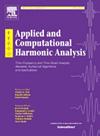利用斜率恢复模式
IF 3.2
2区 数学
Q1 MATHEMATICS, APPLIED
引用次数: 0
摘要
SLOPE是高维回归中常用的降维方法。其估计系数可以为零,产生稀疏性,或者绝对值相等,产生聚类。因此,SLOPE可以消除不相关的预测因子,并确定对响应具有相同影响的预测因子组。SLOPE模式的概念允许我们形式化并研究其稀疏性和聚类属性。特别是,系数向量的SLOPE模式捕获其分量的符号(正、负或零)、聚类(具有相同绝对值的系数组)以及这些聚类的排名。这是第一篇深入研究SLOPE模式一致性的论文。我们建立了SLOPE图恢复的充分必要条件,从而推导出给定固定设计矩阵x的SLOPE的不可表示性条件,这些结果为斜率图一致性的全面渐近分析奠定了基础。本文章由计算机程序翻译,如有差异,请以英文原文为准。
Pattern recovery by SLOPE
SLOPE is a popular method for dimensionality reduction in high-dimensional regression. Its estimated coefficients can be zero, yielding sparsity, or equal in absolute value, yielding clustering. As a result, SLOPE can eliminate irrelevant predictors and identify groups of predictors that have the same influence on the response. The concept of the SLOPE pattern allows us to formalize and study its sparsity and clustering properties. In particular, the SLOPE pattern of a coefficient vector captures the signs of its components (positive, negative, or zero), the clusters (groups of coefficients with the same absolute value), and the ranking of those clusters. This is the first paper to thoroughly investigate the consistency of the SLOPE pattern. We establish necessary and sufficient conditions for SLOPE pattern recovery, which in turn enable the derivation of an irrepresentability condition for SLOPE given a fixed design matrix . These results lay the groundwork for a comprehensive asymptotic analysis of SLOPE pattern consistency.
求助全文
通过发布文献求助,成功后即可免费获取论文全文。
去求助
来源期刊

Applied and Computational Harmonic Analysis
物理-物理:数学物理
CiteScore
5.40
自引率
4.00%
发文量
67
审稿时长
22.9 weeks
期刊介绍:
Applied and Computational Harmonic Analysis (ACHA) is an interdisciplinary journal that publishes high-quality papers in all areas of mathematical sciences related to the applied and computational aspects of harmonic analysis, with special emphasis on innovative theoretical development, methods, and algorithms, for information processing, manipulation, understanding, and so forth. The objectives of the journal are to chronicle the important publications in the rapidly growing field of data representation and analysis, to stimulate research in relevant interdisciplinary areas, and to provide a common link among mathematical, physical, and life scientists, as well as engineers.
 求助内容:
求助内容: 应助结果提醒方式:
应助结果提醒方式:


